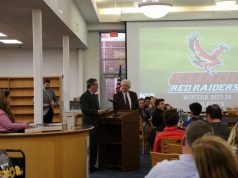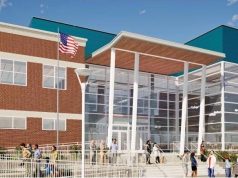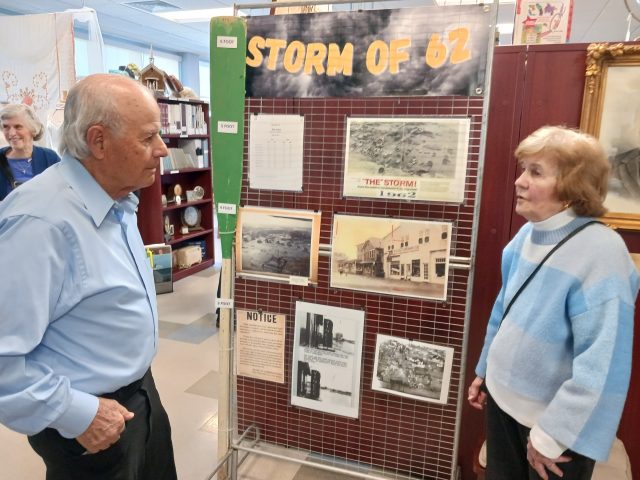
By DONALD WITTKOWSKI
Of all the terrifying moments Diana Perry experienced during the 1962 Ash Wednesday storm at the Jersey Shore, one in particular still serves as a haunting reminder of the superstorm’s fury when it destroyed much of Sea Isle City.
At the time, she was living in a garage apartment on 41st Street and Pleasure Avenue with her husband, Bill, their 4-year-old son, Billy Jr., and their infant daughter, Diana Lynne.
As the colossal storm grew in intensity, she peered out of the apartment’s picture window and saw the facade of the Madeline Theater tilting in the howling winds before the entire building collapsed and vanished into the ocean.
“To stand there and watch that building go down was one of the most eerie feelings I had,” Perry recalled.
Perry, now 88, was one of the storm survivors who gave harrowing accounts during a presentation Saturday by the Sea Isle City Historical Museum on the 62nd anniversary of the Ash Wednesday storm that battered the shore on March 6-8, 1962.
Titled “Our Perfect Storm and Our Community’s Perfect Response,” the presentation chronicled not only the widespread devastation to homes, businesses and other Sea Isle landmarks, but also how local residents pulled together to rebuild the shattered town.
“It’s amazing what these people did,” said Joseph LaRosa Jr., who witnessed the storm as a 9-year-old boy growing up in Sea Isle and would later write about the devastation and recovery efforts in two books, “Our Perfect Storm” and “Storm Stories: An Oral History.”
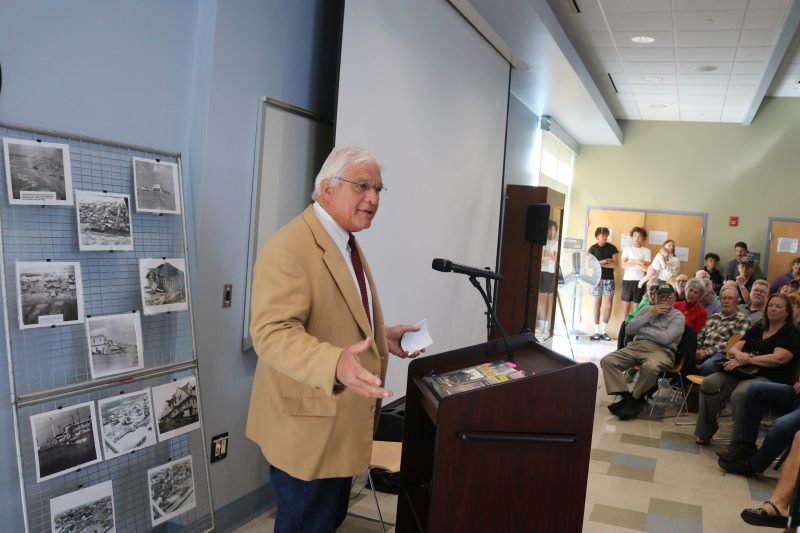
Speaking before an overflow crowd of close to 200 people, LaRosa recalled how neighbors generously helped their fellow neighbors during the storm, including opening up their homes to give them food, shelter and comfort.
“Someone’s always there to help. That’s how these people were in ’62 and are today,” he said of the community spirit in Sea Isle that existed then and continues now.
During the presentation, Mayor Leonard Desiderio drew comparisons between Sea Isle’s communitywide response during the 1962 storm and the recovery efforts in the aftermath of Hurricane Sandy in 2012.
He said Sea Isle “copied some ideas” from 1962 to help recover and rebuild following Sandy’s blow to the shore.
“What happened in the ’62 storm transformed our entire community,” Desiderio said.
“Sea Isle worked together to rebuild the community,” he added.

LaRosa, a retired educator, grew up with his brother, Pat, in a home on 43rd Street and Central Avenue owned by their late parents, Joseph Sr. and Alice LaRosa. His father worked as the assistant superintendent of Sea Isle City’s Public Works department and was well known in town.
Because of his father’s role with the city, LaRosa quickly became aware of the devastation that the storm inflicted on Sea Isle.
“One day in March of ’62, my childhood disappeared. Everything disappeared,” he said of the traumatic experience he suffered.
Among other landmarks that were lost to the storm’s surging waves, howling winds and flooding that was 4 or 5 feet deep were the Madeline Theater, the Excursion House, the Windsor Hotel, the Marconi Carousel and the Sisters of Mercy Convent, along with much, much more.
The Boardwalk served as the defining symbol of the storm’s wrath. The oceanfront walkway, the epicenter of Sea Isle’s tourism trade, was reduced to twisted and mangled bits of wood rubble.
Realizing the vulnerability of having a wood structure so close to the powerful waves, the city replaced what little was left of the Boardwalk with the asphalt and concrete Promenade walkway that stands today.
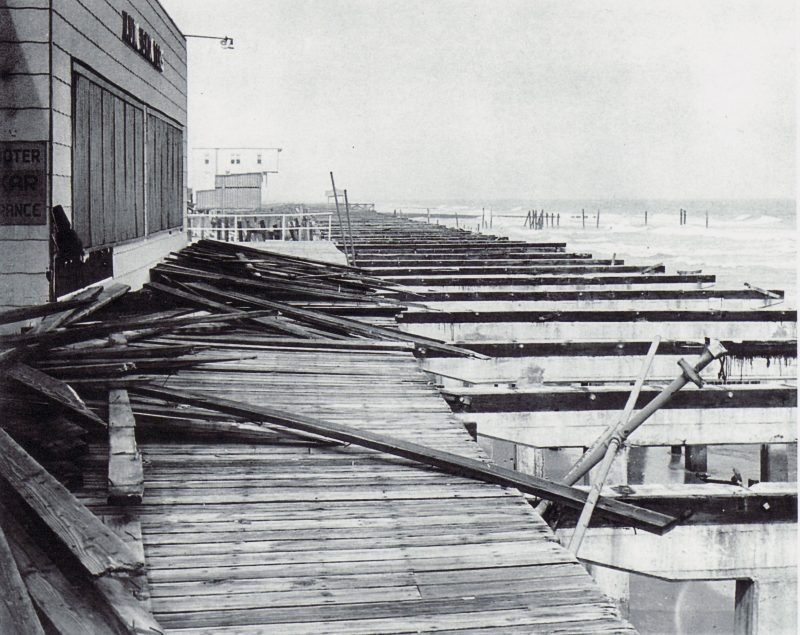
Sea Isle was a small town of about 1,300 residents in 1962. Virtually every home and building was damaged by the storm. Overall, 250 buildings were destroyed and 1,200 sustained structural damage, LaRosa said.
To get rid of all the rubble and debris, the town set a great bonfire on an isolated part of the island that burned for months, 24 hours a day, he noted.
Widespread street flooding made it impossible to escape the island by car. But like hundreds of other Sea Isle residents, LaRosa and his family were forced to flee the storm in Navy and Coast Guard helicopters that airlifted them to safety on the mainland.
Diana Perry, describing the challenges her family faced while trying to evacuate when she had a young son and infant daughter, jumped in the car and attempted to drive through the flooding. Eventually, the car flooded and died.
Unable to get back home, her family was taken in by Sea Isle resident Fred Miller and his family. They stayed at the Miller home on 47th Street for two or three days to ride out the storm before being evacuated by helicopter.
“They were very welcoming to us and gracious to us,” Perry said of the Millers.
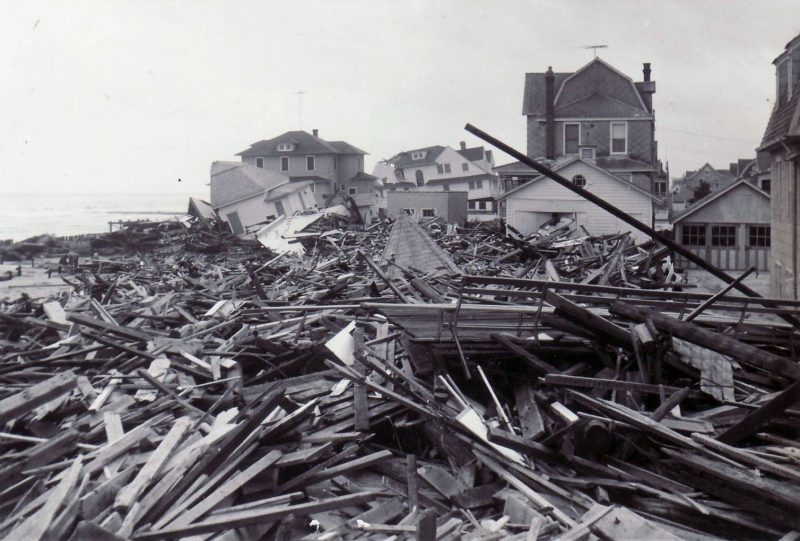
Perry’s husband and two children are deceased now. Looking back at 1962, Perry recalled seeing things that were incredible, including the collapse of the Madeline Theater. The theater was owned by her grandfather, Louis Braca.
“Lumber, chairs, benches and whole layers of steps flooding by in the street,” Perry recounted of the debris being swept away by her apartment.
Jack Gibson, 89, who is a Sea Isle councilman now, was appointed acting engineer for Cape May County in 1962. As county engineer, his priority was restoring access to the island by reopening the flooded roads and causeways into town.
“We did lose the whole road coming into town,” Gibson said of the old Sea Isle Boulevard causeway.
The road was rebuilt. The county also constructed a new bridge in the aftermath of the storm. The bridge is the same one that motorists take from Sea Isle Boulevard to the John F. Kennedy Boulevard corridor entering town.
The new bridge had been planned prior to the storm, but the devastation caused by the nor’easter certainly underscored the importance of having a modern transportation structure towering over the surrounding flood-prone bay and marshlands, Gibson said.
Gibson was able to see the extent of the flooding in 1962 from the air. His family also evacuated the island by helicopter.

The Sea Isle City Historical Museum has a special exhibit on the 1962 storm open to the public. For more information on the museum and its exhibits, visit seaislemuseum.com. Father and daughter Pat and Caitlin Haffert helped museum curator Abby Powell create the storm exhibit. The Hafferts also organized the storm presentation on Saturday.


